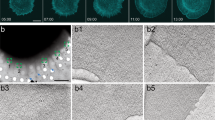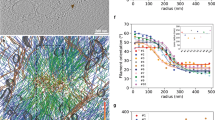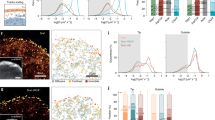Abstract
Eukaryotic cells can initiate movement using the forces exerted by polymerizing actin filaments to extend lamellipodial and filopodial protrusions. In the current model, actin filaments in lamellipodia are organized in a branched, dendritic network. We applied electron tomography to vitreously frozen 'live' cells, fixed cells and cytoskeletons, embedded in vitreous ice or in deep-negative stain. In lamellipodia from four cell types, including rapidly migrating fish keratocytes, we found that actin filaments are almost exclusively unbranched. The vast majority of apparent filament junctions proved to be overlapping filaments, rather than branched end-to-side junctions. Analysis of the tomograms revealed that actin filaments terminate at the membrane interface within a zone several hundred nanometres wide at the lamellipodium front, and yielded the first direct measurements of filament densities. Actin filament pairs were also identified as lamellipodium components and bundle precursors. These data provide a new structural basis for understanding actin-driven protrusion during cell migration.
This is a preview of subscription content, access via your institution
Access options
Subscribe to this journal
Receive 12 print issues and online access
$209.00 per year
only $17.42 per issue
Buy this article
- Purchase on Springer Link
- Instant access to full article PDF
Prices may be subject to local taxes which are calculated during checkout






Similar content being viewed by others
References
Small, J. V. Organization of actin in the leading edge of cultured cells: influence of osmium tetroxide and dehydration on the ultrastructure of actin meshworks. J. Cell Biol. 91, 695–705 (1981).
Hoglund, A. S., Karlsson, R., Arro, E., Fredriksson, B. A. & Lindberg, U. Visualization of the peripheral weave of microfilaments in glia cells. J. Muscle Res. Cell Motil. 1, 127–146 (1980).
Small, J. V., Rinnerthaler, G. & Hinssen, H. Organization of actin meshworks in cultured cells: the leading edge. Cold Spring Harb. Symp. Quant. Biol. 46, 599–611 (1982).
Small, J. V., Isenberg, G. & Celis, J. E. Polarity of actin at the leading edge of cultured cells. Nature 272, 638–639 (1978).
Small, J. V., Herzog, M. & Anderson, K. Actin filament organization in the fish keratocyte lamellipodium. J. Cell Biol. 129, 1275–1286 (1995).
Svitkina, T. M., Verkhovsky, A. B., McQuade, K. M. & Borisy, G. G. Analysis of the actin-myosin II system in fish epidermal keratocytes: mechanism of cell body translocation. J. Cell Biol. 139, 397–415 (1997).
Wang, Y. L. Exchange of actin subunits at the leading edge of living fibroblasts: possible role of treadmilling. J. Cell Biol. 101, 597–602 (1985).
Okabe, S. & Hirokawa, N. Incorporation and turnover of biotin-labeled actin microinjected into fibroblastic cells: an immunoelectron microscopic study. J. Cell Biol. 109, 1581–1595 (1989).
Symons, M. H. & Mitchison, T. J. Control of actin polymerization in live and permeabilized fibroblasts. J. Cell Biol. 114, 503–513 (1991).
Lai, F. P. et al. Arp2/3 complex interactions and actin network turnover in lamellipodia. EMBO J. 7, 982–992 (2008).
Pollard, T. D. Regulation of actin filament assembly by arp2/3 complex and formins. Annu. Rev. Biophys. Biomol. Struct. 36, 451–477 (2007).
Le Clainche, C. & Carlier, M. F. Regulation of actin assembly associated with protrusion and adhesion in cell migration. Physiol. Rev. 88, 489–513 (2008).
Mullins, R. D., Heuser, J. A. & Pollard, T. D. The interaction of Arp2/3 complex with actin: nucleation, high affinity pointed end capping, and formation of branching networks of filaments. Proc. Natl Acad. Sci. USA 95, 6181–6186 (1998).
Pollard, T. D. & Borisy, G. G. Cellular motility driven by assembly and disassembly of actin filaments. Cell 112, 453–465 (2003).
Machesky, L. M., Atkinson, S. J., Ampe, C., Vandekerckhove, J. & Pollard, T. D. Purification of a cortical complex containing two unconventional actins from Acanthamoeba by affinity chromatography on profilin-agarose. J. Cell Biol. 127, 107–115 (1994).
Welch, M. D., DePace, A. H., Verma, S., Iwamatsu, A. & Mitchison, T. J. The human Arp2/3 complex is composed of evolutionarily conserved subunits and is localized to cellular regions of dynamic actin filament assembly. J. Cell Biol. 138, 375–384 (1997).
Machesky, L. M. & Insall, R. H. Scar1 and the related Wiskott-Aldrich syndrome protein, WASP, regulate the actin cytoskeleton through the Arp2/3 complex. Curr. Biol. 8, 1347–1356 (1998).
Kunda, P., Craig, G., Dominguez, V. & Baum, B. Abi, Sra1, and Kette control the stability and localization of SCAR/WAVE to regulate the formation of actin-based protrusions. Curr. Biol. 13, 1867–1875 (2003).
Steffen, A. et al. Sra-1 and Nap1 link Rac to actin assembly driving lamellipodia formation. EMBO J. 23, 749–759 (2004).
Rogers, S. L., Wiedemann, U., Stuurman, N. & Vale, R. D. Molecular requirements for actin-based lamella formation in Drosophila S2 cells. J. Cell Biol. 162, 1079–1088 (2003).
Loisel, T. P., Boujemaa, R., Pantaloni, D. & Carlier, M. F. Reconstitution of actin-based motility of Listeria and Shigella using pure proteins. Nature 401, 613–616 (1999).
Takenawa, T. & Suetsugu, S. The WASP-WAVE protein network: connecting the membrane to the cytoskeleton. Nat. Rev. Mol. Cell Biol. 8, 37–48 (2007).
Stradal, T. E. & Scita, G. Protein complexes regulating Arp2/3-mediated actin assembly. Curr. Opin. Cell Biol. 18, 4–10 (2006).
Nakagawa, H. et al. IRSp53 is colocalised with WAVE2 at the tips of protruding lamellipodia and filopodia independently of Mena. J. Cell Sci. 116, 2577–2583 (2003).
Amann, K. J. & Pollard, T. D. Direct real-time observation of actin filament branching mediated by Arp2/3 complex using total internal reflection fluorescence microscopy. Proc. Natl Acad. Sci. USA 98, 15009–15013 (2001).
Pantaloni, D., Boujemaa, R., Didry, D., Gounon, P. & Carlier, M. F. The Arp2/3 complex branches filament barbed ends: functional antagonism with capping proteins. Nat. Cell Biol. 2, 385–391 (2000).
Volkmann, N. et al. Structure of Arp2/3 complex in its activated state and in actin filament branch junctions. Science 293, 2456–2459 (2001).
Rouiller, I. et al. The structural basis of actin filament branching by the Arp2/3 complex. J. Cell Biol. 180, 887–895 (2008).
Svitkina, T. M. & Borisy, G. G. Arp2/3 complex and actin depolymerizing factor/cofilin in dendritic organization and treadmilling of actin filament array in lamellipodia. J Cell Biol. 145, 1009–1026 (1999).
Koestler, S. A., Auinger, S., Vinzenz, M., Rottner, K. & Small, J. V. Differentially oriented populations of actin filaments generated in lamellipodia collaborate in pushing and pausing at the cell front. Nat. Cell Biol. 10, 306–313 (2008).
Baumeister, W. Electron tomography: towards visualizing the molecular organization of the cytoplasm. Curr. Opin. Struct. Biol. 12, 679–684 (2002).
Steven, A. C. & Aebi, U. The next ice age: cryo-electron tomography of intact cells. Trends Cell Biol. 13, 107–110 (2003).
Medalia, O. et al. Macromolecular architecture in eukaryotic cells visualized by cryoelectron tomography. Science 298, 1209–1213 (2002).
Nemethova, M., Auinger, S. & Small, J. V. Building the actin cytoskeleton: filopodia contribute to the construction of contractile bundles in the lamella. J. Cell Biol. 180, 1233–1244 (2008).
Auinger, S. & Small, J. V. Correlated light and electron microscopy of the cytoskeleton. Methods Cell Biol. 88, 257–272 (2008).
Verkhovsky, A. B. et al. Orientational order of the lamellipodial actin network as demonstrated in living motile cells. Mol. Biol. Cell 14, 4667–4675 (2003).
Steinmetz, M. O., Stoffler, D., Hoenger, A., Bremer, A. & Aebi, U. Actin: from cell biology to atomic detail. J. Struct. Biol. 119, 295–320 (1997).
Flinn, H. M. & Ridley, A. J. Rho stimulates tyrosine phosphorylation of focal adhesion kinase, p130 and paxillin. J. Cell Sci. 109, 1133–1141 (1996).
Koestler, S. A. et al. F- and G-actin concentrations in lamellipodia of moving cells. PLoS ONE 4, e4810 (2009).
Vallotton, P. & Small, J. V. Shifting views on the leading role of the lamellipodium in cell migration: speckle tracking revisited. J. Cell Sci. 122, 1955–1958 (2009).
Ponti, A., Machacek, M., Gupton, S. L., Waterman-Storer, C. M. & Danuser, G. Two distinct actin networks drive the protrusion of migrating cells. Science 305, 1782–1786 (2004).
Lebensohn, A. M. & Kirschner, M. Activation of the WAVE complex by coincident signals controls actin assembly. Cell 36, 512–524 (2009).
Pollard, T. D. & Cooper, J. A. Actin, a central player in cell shape and movement. Science 326, 1208–1212 (2009).
Flanagan, L. A. et al. Filamin A, the Arp2/3 complex, and the morphology and function of cortical actin filaments in human melanoma cells. J. Cell Biol. 155, 511–517 (2001).
Hotulainen, P. & Lappalainen, P. Stress fibers are generated by two distinct actin assembly mechanisms in motile cells. J. Cell Biol. 173, 383–394 (2006).
Langanger, G. et al. Ultrastructural localization of α-actinin and filamin in cultured cells with the immunogold staining (IGS) method. J. Cell Biol. 99, 1324–1334 (1984).
Dickinson, R. B. Models for actin polymerization motors. J. Math. Biol. 58, 81–103 (2009).
Miki, H., Yamaguchi, H., Suetsugu, S. & Takenawa, T. IRSp53 is an essential intermediate between Rac and WAVE in the regulation of membrane ruffling. Nature 408, 732–735 (2000).
Krugmann, S. et al. Cdc42 induces filopodia by promoting the formation of an IRSp53:Mena complex. Curr. Biol. 11, 1645–1655 (2001).
Breitsprecher, D. et al. Clustering of VASP actively drives processive, WH2 domain-mediated actin filament elongation. EMBO J. 27, 2943–2954 (2008).
Schirenbeck, A. et al. The bundling activity of vasodilator-stimulated phosphoprotein is required for filopodium formation. Proc. Natl Acad. Sci. USA 103, 7694–7699 (2006).
Chesarone, M. A. & Goode, B. L. Actin nucleation and elongation factors: mechanisms and interplay. Curr. Opin. Cell Biol. 21, 28–37 (2009).
Yang, C. et al. Novel roles of formin mDia2 in lamellipodia and filopodia formation in motile cells. PLoS Biol. 5, e317 (2007).
Block, J. et al. Filopodia formation induced by active mDia2/Drf3. J. Microsc. 231, 506–517 (2008).
Nakagawa, H., Terasaki, A. G., Suzuki, H., Ohashi, K. & Miyamoto, S. Short-term retention of actin filament binding proteins on lamellipodial actin bundles. FEBS Lett. 580, 3223–3228 (2006).
Vignjevic, D. et al. Role of fascin in filopodial protrusion. J. Cell Biol. 174, 863–875 (2006).
Faix, J. & Rottner, K. The making of filopodia. Curr. Opin. Cell Biol. 18, 18–25 (2006).
Mattila, P. K. & Lappalainen, P. Filopodia: molecular architecture and cellular functions. Nat. Rev. Mol. Cell. Biol. 9, 446–454 (2008).
DeRosier, D. J. & Tilney, L. G. F-actin bundles are derivatives of microvilli: What does this tell us about how bundles might form? J. Cell Biol. 148, 1–6 (2000).
Small, J. V. The actin cytoskeleton. Electron Microsc. Rev. 1, 155–174 (1988).
Brieher, W. M., Coughlin, M. & Mitchison, T. J. Fascin-mediated propulsion of Listeria monocytogenes independent of frequent nucleation by the Arp2/3 complex. J. Cell Biol. 165, 233–242 (2004).
Cameron, L. A., Svitkina, T. M., Vignjevic, D., Theriot, J. A. & Borisy, G. G. Dendritic organization of actin comet tails. Curr. Biol. 11, 130–135 (2001).
Anderson, K. S. & Small, J. V. Preparation and fixation of fish keratocytes. Cell Biology: A laboratory Handbook, Vol. 2, 372–376 (Academic, 1998).
Anderson, K. I., Wang, Y. L. & Small, J. V. Coordination of protrusion and translocation of the keratocyte involves rolling of the cell body. J. Cell Biol. 134, 1209–1218 (1996).
Mastronarde, D. N. Automated electron microscope tomography using robust prediction of specimen movements. J. Struct. Biol. 152, 36–51 (2005).
Kremer, J. R., Mastronarde, D. N. & McIntosh, J. R. Computer visualization of three-dimensional image data using IMOD. J. Struct. Biol. 116, 71–76 (1996).
Frangakis, A. S. & Hegerl, R. Noise reduction in electron tomographic reconstructions using nonlinear anisotropic diffusion. J. Struct. Biol. 135, 239–250 (2001).
Acknowledgements
We thank T. Kulcsar for help with graphics, M. Brandstaetter for support in electron microscopy, T. Stradal and K. Rottner for the p16 ArpC5 construct, and R. Tsien for mCherry. J.V.S. was supported by the Austrian Science Research Council and the Vienna Science Research and Technology Fund (WWTF). G.P.R and J.V.S. acknowledge the support by the City of Vienna/Zentrum für Innovation und Technologie through the spot of excellence grant “Center of Molecular and Cellular Nanostructure”.
Author information
Authors and Affiliations
Contributions
E.U. and S.J. prepared experimental material and performed electron tomography, image processing and image analysis. M.N. prepared experimental material and performed correlated live-cell imaging and image analysis. E.U., S.J. and M.N. prepared the figures. G.P.R. set up the tomography facility, provided advice and assistance with tomography, cryofixation and image processing. J.V.S. conceived the project, contributed to image analysis and wrote the manuscript with feedback from co-authors.
Corresponding author
Ethics declarations
Competing interests
The authors declare no competing financial interests.
Supplementary information
Supplementary Information
Supplementary Information (PDF 1810 kb)
Supplementary Information
Supplementary Movie 1 (MOV 14667 kb)
Supplementary Information
Supplementary Movie 2 (MOV 8438 kb)
Supplementary Information
Supplementary Movie 3 (MOV 36412 kb)
Supplementary Information
Supplementary Movie 4a (MOV 5992 kb)
Supplementary Information
Supplementary Movie 4b (MOV 9449 kb)
Supplementary Information
Supplementary Movie 5 (MOV 27 kb)
Supplementary Information
Supplementary Movie 6 (MOV 12001 kb)
Supplementary Information
Supplementary Movie 7 (MOV 13934 kb)
Rights and permissions
About this article
Cite this article
Urban, E., Jacob, S., Nemethova, M. et al. Electron tomography reveals unbranched networks of actin filaments in lamellipodia. Nat Cell Biol 12, 429–435 (2010). https://doi.org/10.1038/ncb2044
Received:
Accepted:
Published:
Issue Date:
DOI: https://doi.org/10.1038/ncb2044
This article is cited by
-
4polar-STORM polarized super-resolution imaging of actin filament organization in cells
Nature Communications (2022)
-
Optogenetic manipulation of cellular communication using engineered myosin motors
Nature Cell Biology (2021)
-
AIM1 is an actin-binding protein that suppresses cell migration and micrometastatic dissemination
Nature Communications (2017)
-
Computational approaches to substrate-based cell motility
npj Computational Materials (2016)
-
Fully Mechanically Controlled Automated Electron Microscopic Tomography
Scientific Reports (2016)



